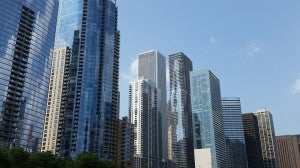Yes, that was Friday’s temperature in Chicago.
But instead of thinking about jetting off to a sandy beach in the Caribbean, my thoughts instead turn to a more practical matter. As I look across the Chicago skyline, I wonder how many of these buildings have old, inefficient heating systems.
The good news is that right here in Chicago, some building owners are finding better, more efficient ways to heat — and in balmier times, cool — their properties.
Over the past year, EDF, the City of Chicago, and some of the city’s leading building owners have teamed up to make real progress in cutting energy use and costs.
The results of this partnership have helped Chicago move closer to the goal of the city’s Retrofit Chicago initiative: reduce commercial energy use in participating buildings by 20 percent in five years. The Mayor’s office has set the bar for energy savings, and EDF Climate Corps is providing boots on the ground to get it done. And Chicago’s leading building owners and operators are showing creativity and innovation in taking their energy management to the next level.
Let me tell you a little more about the buildings that are driving energy efficiency in Chicago:
77 West Wacker, an all-electric JLL property, is a shining model of energy management in Class A buildings. In ten years, 77 West Wacker has gone from working toward LEED certification to being one of Chicago’s most energy-efficient buildings.
By collecting and analyzing building data, 77 West Wacker was able to find energy-saving opportunities through customizations to its Building Automation System (BAS). So when last year’s polar vortex hit Chicago and energy prices spiked for a 12-hour period, 77 West Wacker was able to preheat the building and reduce energy consumption by over 1,000 kWh per hour during the cold spell.
325 West Huron is located in one of Chicago’s hottest neighborhoods. A Class B building owned by Urban Innovations, this property has a steam boiler that’s over 100 years old. But thanks to Jason Szczur, Urban Innovations’ chief engineer, the boiler is now an environmental asset. By installing new igniters, tubes, heating elements, and insulation, Jason was able to improve the energy efficiency of the building.
Both 77 West Wacker and Urban Innovations joined Retrofit Chicago in 2014, with help from the energy-saving strategies developed by their EDF Climate Corps fellows.
Shorenstein Properties’ River North Point is 1.2 million square feet of office and creative space originally built in the 1970s. Now, it is LEED Gold certified and modeling sustainability through consistent improvements since 2009. In 2014, EDF Climate Corps worked with River North Point to take advantage of ComEd’s Retro-Commissioning program and expand tenant engagement in energy efficiency.
Chicago’s Merchandise Mart, one of the largest commercial buildings in the world, continues to find energy savings for their property and their tenants. Through good old-fashioned data collection, EDF Climate Corps was able to identify 520,000 kWh of electricity that could be saved annually by reducing after-hours use.
There’s still work to be done. But take inspiration from the progress that EDF Climate Corps, the City of Chicago, and leading businesses have made in reducing energy use in Chicago. We’re just getting warmed up!
This post originally appeared on our EDF Climate Corps blog.










